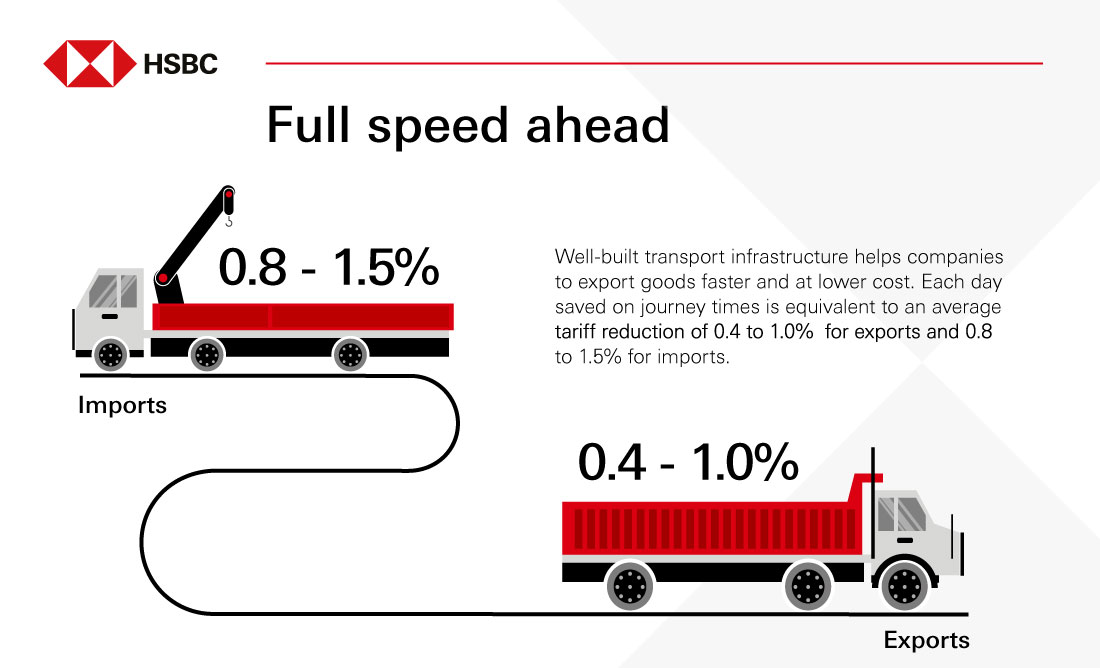- Article

- Growing my Business
- Expanding Abroad
Connecting the world
As part of a four-article series, HSBC examines how the Belt and Road Initiative (BRI) is evolving in response to the lessons and challenges experienced so far and what this could mean for the global economy, from climate change to regional economic development and from project governance to trade connectivity. Our second article explores how the BRI is moving from infrastructure projects to a broader focus on increased cross-border and international connectivity.
In its early years, the BRI was largely a transportation and energy infrastructure play, focusing on physical assets, from railways and roads to power systems. The end goal, though, is not simply to amass disconnected assets; it is to use infrastructure to drive connectivity at the cross-border, regional and global levels. From Thailand’s Eastern Economic Corridor initiative1 to the China-Pakistan Economic Corridor, BRI projects are now helping to knit countries together.2
We see the BRI as a new, multilateral framework for globalisation that will influence the profile of investment, trade, wealth and migration everywhere. The joint communique issued after the Second Belt and Road Forum for International Cooperation in April this year referred more than 20 times to connectivity, stating that the BRI promotes “exchanges, mutual learning and dialogue among different peoples, cultures and civilisations”.3
Physical economic integration deepens international relationships and facilitates financial flows and the movement of people – whether they be business professionals, workers, or students and young people. China has long sought to connect to the wider world. Its businesses can be found everywhere, from rural Africa to offshore wind farms by the English coast. China’s overseas student population has seen a steady increase, with over 660,000 Chinese studying abroad in 2018, and the country is building scientific and academic partnerships with universities around the globe.4
The BRI can promote this flow of businesses, ideas and people across participating countries. Transport infrastructure, on land and sea, helps companies to export goods faster and at lower cost, which can strengthen globalisation. One study found that each day saved on journey times is equivalent to an average tariff reduction of 0.4-1.0% for exports and 0.8-1.5% for imports.5 Improved transport encourages firms to find new locations outside congested urban areas, bringing jobs to less-developed regions and supporting economic decentralisation.
Transport infrastructure can also support bilateral trade over long distances. Chinese exports to France, for instance, include construction and manufacturing machinery, textiles and appliances, while French exports to China include passenger vehicles, aircraft, chemicals, water treatment hardware, and food and beverages. Politicians and corporate leaders from both countries have publicly stated that the BRI can support their US$62.9bn bilateral trade relationship going forward.6 Equally important is the flow of people, to carry ideas and forge relationships.
Connectivity is also being enhanced by new cooperative models in the BRI era. Bidding by consortia, for example, is one approach that can benefit projects by mixing the best contractors from China with the best skills, resources and execution capabilities from Europe, North America or elsewhere. Another mechanism is "third-party market cooperation" agreements, under which countries across Asia, Europe and North America have signed up to work with China to build infrastructure in developing countries. These partnerships will combine China’s manufacturing and production expertise with developed countries’ advanced technologies to meet the needs of emerging markets.
The partnership ethic is not just between big businesses or governments. It can apply to communities and civil-society groups, which must play a role in BRI project design and monitoring to ensure mutual benefits. It can also apply to small- and medium-sized enterprises (SMEs) which stand to gain from the BRI. China sees connectivity as a means of helping its SMEs to go global, and has promised to support them through mechanisms like establishing domestic demonstration centres for their products and technologies. China can use its global network to guide SMEs into new markets, as with its SME centre in Berlin, which helps Chinese companies to access the German economy.7
SMEs from other countries also stand to benefit from the BRI’s connectivity. Infrastructure projects create opportunities for SMEs seeking to access the Chinese economy, and construction itself creates business openings in everything from materials supply to the daily necessities of the building industry and its workers.
This connectivity is a boon to global production, providing emerging countries with the infrastructure necessary to reach new markets and stimulate regional business. The BRI is seen by many as a global infrastructure project, but by facilitating lasting connections the initiative’s benefits stretch far beyond physical assets.
Produced by (E) BrandConnect, a commercial division of The Economist Group, which operates separately from the editorial staffs of The Economist and The Economist Intelligence Unit. Neither (E) BrandConnect nor its affiliates accept any responsibility or liability for reliance by any party on this content.
Politicians and corporate leaders from France and China have publicly stated that the BRI can support their US$
62.9bn
bilateral trade relationship going forward
China’s overseas student population has seen a steady increase, with over
660,000
Chinese studying abroad in 2018
In its early years, the BRI was largely a transportation and energy infrastructure play, focusing on physical assets, from railways and roads to power systems. The end goal, though, is not simply to amass disconnected assets; it is to use infrastructure to drive connectivity at the cross-border, regional and global levels. From Thailand’s Eastern Economic Corridor initiative to the China-Pakistan Economic Corridor, BRI projects are now helping to knit countries together.
3 http://www.beltandroadforum.org/english/
4 http://www.chinadaily.com.cn/a/201903/28/WS5c9c355da3104842260b30eb.html
5 https://www.rand.org/content/dam/rand/pubs/research_reports/RR2600/RR2625/RAND_RR2625.pdf
6 https://www.telegraph.co.uk/china-watch/business/bri-to-benefit-sino-french-commerce/
7 http://english.gov.cn/news/policy_briefings/2019/04/13/content_281476606935448.htm



